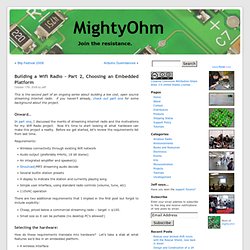

Wave Bubble. Two Wavebubbles.

Left is an earlier revision with the top removed and with external antennas. Right is v1.0 with internal antennas, fit into a pack of cigarettes. This website details the design and construction Wave Bubble: a self-tuning, wide-bandwidth portable RF jammer. The device is lightweight and small for easy camouflaging: it is the size of a pack of cigarettes. An internal lithium-ion battery provides up to 2 hours of jamming (two bands, such as cell) or 4 hours (single band, such as cordless phone, GPS, WiFi, bluetooth, etc).
Output power is .1W (high bands) and .3W (low bands). Self-tuning is provided via dual PLL, therefore, no spectrum analyzer is necessary to build this jammer and a single Wave Bubble can jam many different frequency bands - unlike any other design currently available! While the documentation here is both accurate and complete (as much as possible), the construction of such a device is still an advanced project. MJRainey - El Silbo. Blog Archive » Building a Wifi Radio - Part 1, Introduction. This article is the first of a series that will document the development of a low cost, open source wireless streaming internet radio receiver.

All construction details, including schematics, source code, and even the design process itself will be documented on this blog. Comments and (constructive) criticism are welcome. Click here to post a comment. Table of Contents: Some background: According to Wikipedia, in 1993 the first internet radio program began distribution. Today, most music playback software supports streaming radio in some way. iTunes features thousands of streaming radio stations and even supports Shoutcast streams so that users can easily add additional stations of their own. The beautiful thing about streaming radio is the huge diversity in programming that is available. In the past couple years, products have started to appear that mimic the form and function of a traditional radio, but play internet radio instead.
The Wifi Radio project: Blog Archive » Building a Wifi Radio - Part 2, Choosing an Embedded Platform. This is the second part of an ongoing series about building a low cost, open source streaming internet radio. if you haven’t already, check out part one for some background about the project.

Onward… In part one, I discussed the merits of streaming internet radio and the motivations for my Wifi Radio project. Now it’s time to start looking at what hardware can make this project a reality. Before we get started, let’s review the requirements list from last time. Requirements: Wireless connectivity through existing Wifi networkAudio output (preferably 44kHz, 16 bit stereo)An integrated amplifier and speaker(s)Shoutcast/MP3 streaming audio decodeSeveral builtin station presetsA display to indicate the station and currently playing songSimple user interface, using standard radio controls (volume, tune, etc)110VAC operation There are two additional requirements that I implied in the first post but forgot to include explicitly: Selecting the hardware: Here it is in all it’s glory: .
Like this: